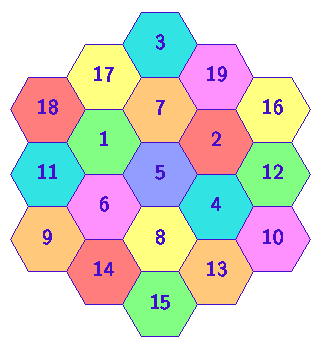The Magic Hexagon

This is a diameter-5 magic hexagon. Each integer from 1 to 19 appears exactly once, and the sum of the numbers along any column or diagonal is the same. It is easy to prove that 1 and 5 are the only possible magic hexagon diameters, using the numbers from 1 to the hexagon size. The diameter-1 magic hexagon is trivial, and the diameter-5 magic hexagon is essentially unique. (There are 12 variations which arise by rotating and reflecting the hexagon under the action of the dihedral group of order 12).
For information on the history of the magic hexagon visit Eric W. Weisstein's World of Mathematics page.
Phil J. Taylor (xptaylor at hotmail dot com) writes:
Hi Professor Kschischang,I have posted Phil's program here. Thank you, Phil!
Thank you for posting information about the Magic Hexagon problem. I have played with the problem for several years and I have attached the simplest C program that I've been able to create that solves the problem. You are welcome to post it or pass it along to others who might be interested.
Cheers,
-Phil J. Taylor
Frank R. Kschischang, April 6, 2004.